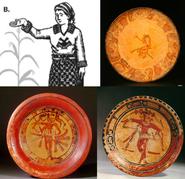
Assistant Professor of Religious Studies Erich Fox Tree presented “La Importancia de los Idiomas de Señas Indígenas para el Desciframiento de la Iconografía Mayas Antigua” (“The Importance of Indigenous Sign Languages for the Decipherment of Ancient Maya Iconography”) at the XXV Simposio de Investigaciones Arqueológicas en Guatemala (The 25th Symposium on Archaeological and Ethnohistorical Research in Guatemala). The symposium was held July 18-22 at the National Museum of Archaeology and Ethnology, in Guatemala City, Guatemala.
Fox Tree’s presentation offered examples of gestures in ancient Maya art that were “readable” using Meemul Tziij, a complex of ancient indigenous sign languages still used by dozens of indigenous groups in southern Mesoamerica. Proposing that the sign languages probably served as a lingua franca in Mesoamerica before European colonization, Fox Tree argued that they were frequently represented in ancient art and that understanding their structure can help reveal conventions for representing gestures, movements and sequencing in ancient art.
He further proposed that that some representations of Meemul Tziij in ancient art are long enough and detailed enough to constitute another form of ancient Mesoamerican writing and that they would not only be the earliest form of written sign language yet found in the world, but would also have been written before every spoken European language except Etruscan, Greek and Latin.
Sponsored by Guatemala’s Ministry of Culture and Sports with support from a collection of institutions including the embassies of France and the United States, the symposium brought together more than 300 international and regional scholars. It included field reports and studies based on research in Guatemala, Mexico and El Salvador.
According to Fox Tree, indigenous Maya scholars expressed special interest in the presentation, commenting that it demonstrated that the local knowledge of Meemul Tziij that modern Mayas still possess should allow them to interpret ancient Maya iconography more effectively than foreign “experts” who lack such knowledge.
At the request of organizers, Fox Tree’s talk will be published next year in the annual proceedings of the museum’s symposium.
Fox Tree is currently in Guatemala supervising two Hamilton undergraduates who are conducting research on indigenous sign languages and human rights while on Emerson Collaborative grants. Rebecca Ross ‘14 is investigating the legal and social roots of contemporary human rights discrimination and Mariela Meza ’13 is investigating how valorization of ancient and contemporary art might help to improve the human rights conditions.
Posted August 1, 2011
